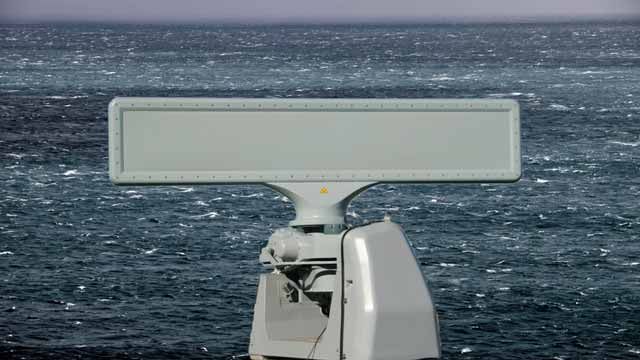Reutech Radar Systems Develops Naval Air and Sea Surveillance Radar with Model-Based Design
“Completing this project on time without Model-Based Design would have been very difficult. The ability to generate code with HDL Coder and to separate signal processing algorithm design from detailed hardware implementation helped us reduce effort on the project by two engineer-years.”
Challenge
Solution
Results
- Development time cut by two engineer-years
- Signal processing designs reused
- Reliable firmware delivered

Designed and built by Reutech Radar Systems (RRS), the RSR 210N is a multipurpose 2D radar used for helicopter support operations as well as general surveillance and ship self-defense. A three-channel pulse Doppler radar system, it is designed to perform efficiently in harsh environments and accurately detect small, fast-moving targets under weather, sea, and land conditions that cause clutter, or unwanted radar echoes.
RRS engineers used Model-Based Design with MATLAB® and Simulink® to develop adaptive detection and signal processing systems for the RSR 210N and implement them on an FPGA.
“Model-Based Design enabled us to separate the engineering effort required for the low-level signal processing architecture—with its associated IO and data transfer channels—from the effort needed for the core signal processing algorithms,” says Kevin Williams, system engineer at RRS. “This approach saved time, reduced risk, and helped us to get the best from a team of engineers from both disciplines.”
Challenge
A radar system built for operation at sea must handle wide-ranging conditions in a dynamic environment. The RRS team needed to update and refine the design rapidly based on data gathered during sea trials. This challenge was compounded by the complexity of the signal processing algorithms, which had to calculate clutter statistics over time to determine thresholds for the adaptive detectors.
In the past, RRS engineers developed similar systems by designing individual elements of the signal processor separately and manually writing HDL code. When the entire design could not fit on a single FPGA, the team had to develop a framework for data communication between the elements. System-level debugging could not begin until the elements were integrated.
RRS engineers wanted to start system-level verification earlier in the development process to identify and resolve defects as soon as possible. They also sought to speed development iterations by automatically generating HDL code instead of writing it by hand.
Solution
RRS engineers developed the RSR 210N signal processing system in MATLAB and Simulink and implemented it in HDL using HDL Coder™.
Working in MATLAB, the engineers developed algorithms for core components of the signal processor. After debugging and verifying the components in MATLAB, they modeled the algorithms in Simulink, using Stateflow® to model state machine control elements.
The engineers integrated individual Simulink models of the signal processor’s digital pulse compressor, Doppler filters, navigation video processor, and adaptive constant false-alarm rate (CFAR) and blade flash detector into a complete system model.
After verifying the accuracy of their algorithms via simulations in Simulink, the engineers converted the floating-point design to fixed point using Fixed-Point Designer™.
The engineers generated more than 75,000 lines of HDL code from their model using HDL Coder.
During FPGA tests, the team logged results and other diagnostic data. This data was postprocessed in MATLAB to verify the HDL implementation against the Simulink model.
The radar system underwent exploratory sea trials. The team used data gathered during these trials to refine the design and optimize key parameters in Simulink before re-generating HDL in preparation for the next trial.
Results
Development time cut by two engineer-years. “Model-Based Design enabled us to reduce development time by about two engineer-years compared with hand-coding,” says Williams. “We spent significantly less time getting our algorithms to function correctly and translating them to HDL.”
Signal processing designs reused. “During the RSR 210N project we established a best practice of parameterizing Simulink component models so that data types, memory depths, bus widths, and other aspects of the design can be easily reconfigured,” says Williams. “As a result, we have been able to reuse several components in other projects.”
Reliable firmware delivered. “The signal processor firmware that we developed using Model-Based Design remained largely unchanged for two years before the first system delivery,” Williams says. “Based on our experience with past projects, we did not expect to achieve that level of reliability and accuracy so early in the process.”